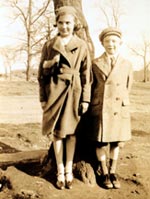 Every community is a living and breathing thing that grows and changes with
time. As the population changes, the body of the community changes and its story
evolves.
Every community is a living and breathing thing that grows and changes with
time. As the population changes, the body of the community changes and its story
evolves.Oral histories, shared by local residents over time, record events, feelings and perspectives found nowhere else. For that reason, the Yorktown Historical Society publishes from time-to-time a selected oral history to share with its readers. The following is part of a survey for a school project in 1940 by Mary Anderson, a resident of Croton Heights. This is an account of life in Yorktown as seen in the eyes of a young woman, and offers a different view from that of an older generation. Mary’s sources consisted of Bolten’s History of Westchester, the Yorktown Herald, Enos Lee (President of the Board of Education), her parents and “old-timers”.
The focus of Mary’s written account is the Heights area of Yorktown just prior to WWII, housing developments and Urban Renewal, which all greatly changed the character of Yorktown forever.
INTRODUCTION
Much of the information included in Mary’s introduction can be found in the text and has been eliminated here, with the exception of the following three paragraphs:
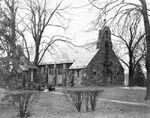 “The churches are the same with the exception of the new Roman Catholic
Church. In place of the small wooden building, there is now an immense stone
building. The number of residences has increased, but with this the number of
trains to pass through our town each day decreases. This shows the increase in
the use of automobiles.
“The churches are the same with the exception of the new Roman Catholic
Church. In place of the small wooden building, there is now an immense stone
building. The number of residences has increased, but with this the number of
trains to pass through our town each day decreases. This shows the increase in
the use of automobiles.Since the coming of good roads, the effect of larger places nearby has been to divert a large portion of the local trade. Such places as Peekskill, White Plains, New York City, and Danbury, Connecticut with their large shopping centers and variety of stores get the bulk of the trade.
There are several residential developments of a high type which attract persons of ample and moderate means. These people work generally in New York City and spend the summer season and winter weekends in our community. There is also the usual small town residential section outside the trading area. A small section near the railroad station is considered the poorer section of town. Outside the village are many small farms.”
POPULATION
“The population of Yorktown Heights as of the last Federal census was 3,571. We are mostly native Americans; that is, consisting mostly of descendants of early colonial settlers. There are farmers, small town merchants, craftsmen, and farm laborers. There are no evidences of manufacturing or factories. There is no social distinction that is noticeable. Every one seems to be of the middle class. There is movement in and out of the community. Yorktown has a tendency of becoming a strictly residential section by a slow influx of people from New York City.”
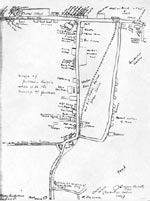 Mary begins her survey of the town with a reference to Yorktown Heights, a
common mistake made even today. Mary’s world was centered around Yorktown
Heights, an area of Yorktown marked by the former train station.
Mary begins her survey of the town with a reference to Yorktown Heights, a
common mistake made even today. Mary’s world was centered around Yorktown
Heights, an area of Yorktown marked by the former train station.
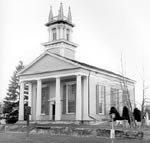 This hamlet
replaced Crompond Corners as the governmental and economic center of town with
the coming of the railroad in the late 1800’s. Crompond Corners was at the site
of the First Presbyterian Church and the intersection of Routes 202 and 132.
This hamlet
replaced Crompond Corners as the governmental and economic center of town with
the coming of the railroad in the late 1800’s. Crompond Corners was at the site
of the First Presbyterian Church and the intersection of Routes 202 and 132. Today the population of Yorktown is 10 times that of 1940 and the make-up of the community has changed dramatically from Mary’s assessment of a “Native American” population! Her use of the term is very interesting, while her view of local ethnicity is naïve. Many immigrants came to Yorktown to build the New Croton Dam in the early part of the century.
COMMUNICATION VS ISOLATION
.jpg) “The railroad made its first appearance forty-five years ago. There were
a great many more trains then a day than there are now.
“The railroad made its first appearance forty-five years ago. There were
a great many more trains then a day than there are now.
 This is due to the fact
that the automobile industry hadn’t started to flourish. The station then was
very beautifully landscaped. A beautiful hotel took care of visitors. Three
carloads of raw milk left Yorktown Heights daily. This situation is now entirely
reversed.” (ed. note. This paragraph was excerpted from Mary’s history
section.)
This is due to the fact
that the automobile industry hadn’t started to flourish. The station then was
very beautifully landscaped. A beautiful hotel took care of visitors. Three
carloads of raw milk left Yorktown Heights daily. This situation is now entirely
reversed.” (ed. note. This paragraph was excerpted from Mary’s history
section.)“For transportation we have roads, buses, and the railroad. For the roads there are routes 118, 132, 100, the Bronx River Parkway and Crompond Road. Routes 118, 100 and the Bronx River Parkway take you to New York City. Route 132 takes you to Peekskill, and Crompond Road takes you to Shrub Oak. There is a bus service morning and evening to Peekskill, just twice a day. The railroad passes through the main part of the village. This is the Putnam division of the New York Central which starts at Grand Central, New York City, and ends at Brewster.”
Road names have changed in the “village” (Heights area) many times since the Revolutionary War. Today Route 132 is called Old Yorktown Road and was named King Street during the Revolution. This route extends from the Presbyterian Church to Shrub Oak. Crompond Road, which goes to Peekskill, was originally the King’s Highway and is now Route 202. Mary may have been confused about these two routes.
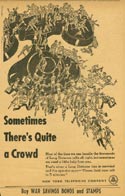 “On April 12, 1938 a new dial system was inaugurated here. This dial system
was the first one to have party lines. There are approximately six hundred
phones in the town of Yorktown.
“On April 12, 1938 a new dial system was inaugurated here. This dial system
was the first one to have party lines. There are approximately six hundred
phones in the town of Yorktown.The local paper is ‘The Yorktown Herald’. This is printed once a week and costs five cents a copy. The people also read ‘The Peekskill Evening Star’ which contains not only Peekskill news, but also general information about our local events. The news in these papers is merely local. Very little is said about national affairs. New York City papers are available daily; ’The New York Times’ and ‘The Herald Tribune’ are read in a great many families.
 A great many families go to the post office every day to receive their mail.
Most of these people have a box in the post office which costs $1.40 a year.
There are rural free delivery routes in places that are a good distance from the
village.
A great many families go to the post office every day to receive their mail.
Most of these people have a box in the post office which costs $1.40 a year.
There are rural free delivery routes in places that are a good distance from the
village.There are contacts with other communities, but these are mostly social such as fire company parades, bazaars,
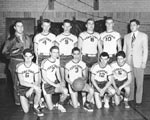 competitive school sports, and a merchant’s
basketball team which competes with other town teams.
competitive school sports, and a merchant’s
basketball team which competes with other town teams. The business opportunities in the town are not sufficient to take care of all those who desire work. Therefore many work out of town in New York City and nearby towns. We are dependent on other towns for hospital care and treatment, but we do have our own water system and fire department.
The coming of radio has improved the knowledge of many who were mainly dependent on the local town paper for news or had obtained their information from visitors. Radio has also discouraged membership or attendance at club or society meetings. Some people have favorite programs and would not let anything interfere with them, and this tends to discourage visiting from home to home.”
From this perspective we can see how easy it was for residents to be isolated from others in their town living in different hamlets. The interesting thing is that today people who live in Shrub Oak, Mohegan Lake and Jefferson Valley have virtually no contact with those in the Kitchawan, Teatown or Pines Bridge area of town. Most are at least familiar with Yorktown Heights, whether to pay their dog license or taxes, attend a town meeting, visit the museum or attend the theater; but local isolation flourishes at a time when we can easily communicate with the world from our homes!
ECONOMIC SITUATION
 “There are several evidences of farming and dairying. Besides the farmers
and dairymen there are craftsmen and building trade mechanics. There are no
merchant societies, therefore they have no influence on the community. There are
four doctors, two lawyers, four ministers, one priest, and twenty-five
schoolteachers. There are no banks or credit associations. This is about the
average Westchester County village. The people have a middle class income, and
about 85% of the families have their own automobiles. It is really a necessity
to own a car in this community. On the whole I would say that the economic
situation of Yorktown is generally good.”
“There are several evidences of farming and dairying. Besides the farmers
and dairymen there are craftsmen and building trade mechanics. There are no
merchant societies, therefore they have no influence on the community. There are
four doctors, two lawyers, four ministers, one priest, and twenty-five
schoolteachers. There are no banks or credit associations. This is about the
average Westchester County village. The people have a middle class income, and
about 85% of the families have their own automobiles. It is really a necessity
to own a car in this community. On the whole I would say that the economic
situation of Yorktown is generally good.”This economic survey seems to be representative of the Heights area only, and not of the entire town.
CHURCHES AND RELIGIOUS SITUATION
“There are five churches in our community. These include the Methodist Episcopal, the Friends, the Presbyterian, the Community, and the Roman Catholic. These are rather small in size. The type of membership is the average town person. The buildings are regularly equipped to carry on church services, Sunday school classes, and to hold meetings of their societies. Some of the general church activities are Young People’s Church Group, Ladies Aid, Willing Workers, Ladies Auxiliary, Missionary Society, Junior and Intermediate Young People’s Society, Rosary Society, The Catholic Club, and the Holy Name Society. There are also Ladies Guild, Altar Guild, Christian Endeavor, and the Men’s Club. There are Sunday school classes in all churches.”
Mary’s reference to five churches is meant to represent the number of church denominations and not actual church parishes. There were at least two Methodist churches, two Friends Meetings and two Catholic churches in Yorktown in 1940.
SCHOOLS AND EDUCATIONAL ORGANIZATIONS
“There is one school in Central District #2 for Yorktown Heights and a few scattered districts. It is a large, well-equipped, modern school building with modern auditorium, gymnasium, and playground, science room, industrial arts workshop, and home economics rooms.
It consists of grades starting with the kindergarten and continuing until and through the twelfth grade or the last year of high school. The teaching staff is complete with a principal and vice-principal at the head. It compares favorably with any other school. Let me give you a short history of the Yorktown School.
Previous to the Revolutionary War there were no schools. Educated men traveled around and lived with the families. They taught the children in these homes. Then two or three families grouped together and the children were taught in a group.
 The first school was at Crompond Corners, the first settlement of the town.
There were as many as thirty pupils in this one-room building. There were twelve
districts with one teacher in each district.”
The first school was at Crompond Corners, the first settlement of the town.
There were as many as thirty pupils in this one-room building. There were twelve
districts with one teacher in each district.” Up to this point Mary is referring to early town-wide school district history. She follows this with a description of the Heights area schools.
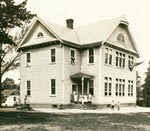 “The next school was a two-room building in the village, located where the
Catholic church (St. Patrick’s stone church) now stands. There were two
teachers and fourteen pupils. Then a four-room wooden building was built in the
same place. There were four teachers.
“The next school was a two-room building in the village, located where the
Catholic church (St. Patrick’s stone church) now stands. There were two
teachers and fourteen pupils. Then a four-room wooden building was built in the
same place. There were four teachers.A law was passed for the consolidation of school districts by the district superintendent if he thought it would be beneficial. Mr. Knapp was the district superintendent. There was a great deal of conflict, but the people finally came to agree (1913).
 In 1929 the central school system came to Yorktown. An eight-room school
(the Yorktown Community and Cultural Center) with gymnasium and auditorium
was built (1920). Miss Sherwood was the principal. Yorktown Heights got nine of
the twelve districts and Shrub Oak, a village in northern Yorktown, got the
other three. Centralization was voted down at least twice, for the people
believed the tax rate would be raised. This conflict lasted over a period of two
years. The state passed a law for a board of education for each town. This was
to have five members, but it was repealed the next year.
In 1929 the central school system came to Yorktown. An eight-room school
(the Yorktown Community and Cultural Center) with gymnasium and auditorium
was built (1920). Miss Sherwood was the principal. Yorktown Heights got nine of
the twelve districts and Shrub Oak, a village in northern Yorktown, got the
other three. Centralization was voted down at least twice, for the people
believed the tax rate would be raised. This conflict lasted over a period of two
years. The state passed a law for a board of education for each town. This was
to have five members, but it was repealed the next year.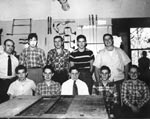 In 1928 the school became overcrowded. A new wing was added which contained
nothing but classrooms. There was a manual training department and a home
economics course. Provisions were made for an agriculture course, but there was
no interest shown in that.
In 1928 the school became overcrowded. A new wing was added which contained
nothing but classrooms. There was a manual training department and a home
economics course. Provisions were made for an agriculture course, but there was
no interest shown in that.
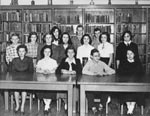 In 1935 a new wing was added with a large gymnasium
and a new library. The school is now full to capacity with over five hundred
pupils, 70% of which are bus students.
In 1935 a new wing was added with a large gymnasium
and a new library. The school is now full to capacity with over five hundred
pupils, 70% of which are bus students. In 1920 there was [sic] only provisions made for two years of high school. When centralization came in 1927, the course was lengthened to four years.
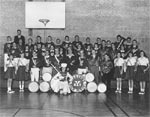 There are about fifteen to twenty young people who go to college. The school
has a general organization, athletic association, Glee Club, Band, Orchestra,
There are about fifteen to twenty young people who go to college. The school
has a general organization, athletic association, Glee Club, Band, Orchestra,
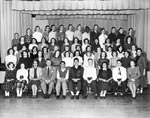 Dramatic Society, Photography Club, Science Club, Girl Reserves Club, Boys’ Club
and Banking Club.
Dramatic Society, Photography Club, Science Club, Girl Reserves Club, Boys’ Club
and Banking Club.There is a Parent Teachers Association, but this is quite poorly attended. Only in the past year has the attendance increased. They seem to accomplish a great deal. When music was wanted in the school, they went out and got it. They got new buses, and also milk for the poorer children.
The principal is Dr. A. Russell Griffen, one of the highest paid educators in the state, especially in Westchester County.
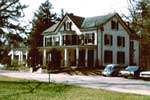 There is a fine library in the school, but this is for the students only. A
public library is open one half day per week for the exchange of books. There
are approximately one thousand volumes in it.”
There is a fine library in the school, but this is for the students only. A
public library is open one half day per week for the exchange of books. There
are approximately one thousand volumes in it.”The principle library-John C. Hart in Shrub Oak-had a satellite site in the “Sixth Grade School” (YCCC) for many years. Heights area residents would welcome such a facility again!
LODGES, CLUBS AND OTHER VOLUNTARY ORGANIZATIONS
.jpg)
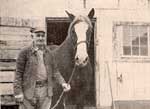 “There
are about twenty-five of these in all. The membership is made up of local
people. There are many social clubs and these include: Bowling Club, Men’s
Church Club, Fire Department and its band, Legion Post, Legion Auxiliary,
Basketball Club, Republic and Democratic Clubs, Flower Club, Women’s Club,
Parent Teachers Association,
Grange, Boy Scouts and Girl Scouts. There are a few informal groups such
as house to house bridge clubs. There are no known cliques or other groups.”
“There
are about twenty-five of these in all. The membership is made up of local
people. There are many social clubs and these include: Bowling Club, Men’s
Church Club, Fire Department and its band, Legion Post, Legion Auxiliary,
Basketball Club, Republic and Democratic Clubs, Flower Club, Women’s Club,
Parent Teachers Association,
Grange, Boy Scouts and Girl Scouts. There are a few informal groups such
as house to house bridge clubs. There are no known cliques or other groups.”RECREATION
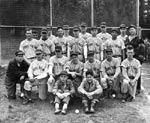 “This
is open country. We have the Mohansic Park Public Golf Links, and also there is
the Amawalk Country Club Golf Course. It is very picturesque country and
therefore there is much talk about hiking.
“This
is open country. We have the Mohansic Park Public Golf Links, and also there is
the Amawalk Country Club Golf Course. It is very picturesque country and
therefore there is much talk about hiking.
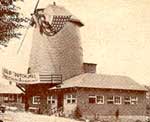 There
are a few ‘swimming holes’ in this vicinity but recently they have been closed
because of germs in the water. All swimming now is done outside of the town.
Beaches along the Hudson are the favored places. The school field is used
for athletics all year round. There are three tennis courts, one basketball
court, and a baseball diamond on the school field. Also for the smaller children
there are swings and slides. There are six drinking places in the village, and
many of the children are known to go there for dancing facilities. The attitude
of the town people toward dancing, cards, and road houses is passive.”
There
are a few ‘swimming holes’ in this vicinity but recently they have been closed
because of germs in the water. All swimming now is done outside of the town.
Beaches along the Hudson are the favored places. The school field is used
for athletics all year round. There are three tennis courts, one basketball
court, and a baseball diamond on the school field. Also for the smaller children
there are swings and slides. There are six drinking places in the village, and
many of the children are known to go there for dancing facilities. The attitude
of the town people toward dancing, cards, and road houses is passive.”Mary is writing this piece as a post-high school student, and refers to her generation of young adults as “children”.
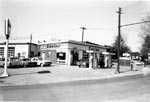 “The needs of Yorktown are many. First of all a theater is wanted. (ed.
note. Mary is referring to a movie theater.) Peekskill and Ossining now
supply this need, but it would prove helpful if Yorktown had its own. More young
people’s societies are needed. There have been evidences of several boy gangs
that have not been too good. One instance to prove this is the fact that they
broke into the Sinclair Gas Station one night at about two o’clock. Healthy
swimming places are also on the list, as well as respectable places for young
people to dance in. I would state that the recreational situation of Yorktown is
bad.”
“The needs of Yorktown are many. First of all a theater is wanted. (ed.
note. Mary is referring to a movie theater.) Peekskill and Ossining now
supply this need, but it would prove helpful if Yorktown had its own. More young
people’s societies are needed. There have been evidences of several boy gangs
that have not been too good. One instance to prove this is the fact that they
broke into the Sinclair Gas Station one night at about two o’clock. Healthy
swimming places are also on the list, as well as respectable places for young
people to dance in. I would state that the recreational situation of Yorktown is
bad.”HEALTH
“There are four private physicians, one town nurse, and one school nurse. A public clinic and health department is conducted in the town hall, and there is no private one. There is also a chapter of the Red Cross in town.
The Rockefeller Institute picked Yorktown as the place in which it would carry on its experiments for influenza. It is supposed to be one of the healthiest communities here in this part of the country.
The school has regular examinations of students by a local physician and a school dentist. There is no hospital or dispensary. The people depend on the ones in Peekskill and Mount Kisco.”
SOCIAL WELFARE
“There are a very few on relief. Last month, October, $150 was expended for relief. This social welfare work is carried on by the American Legion, other societies and also the town welfare master.
There seems to be no antagonistic attitude of the people toward those on relief or those in need. There is very little delinquency in town. There is no place in town which could be called a slum area. This is with the exception of the homes just in back of the railroad station, and then probably it wouldn’t be called a true slum area.”
POLITICAL SETUP
 “Yorktown is a Republican stronghold. The Democrats are the only ones who
offer any kind of opposition.
“Yorktown is a Republican stronghold. The Democrats are the only ones who
offer any kind of opposition.The dominant personalities are Theodore Hill, assemblyman of the second district, and John Downing, supervisor. These are both Republicans. The leader of the Democrats is Edward Dunning.
 There is a town board consisting of a supervisor and four councilmen. Other
officials are Town Superintendent, Receiver of Taxes, Town Clerk, Town Attorney,
Building Inspector, Justices of the Peace, Public Health Nurse, and Register of
Vital Statistics.
There is a town board consisting of a supervisor and four councilmen. Other
officials are Town Superintendent, Receiver of Taxes, Town Clerk, Town Attorney,
Building Inspector, Justices of the Peace, Public Health Nurse, and Register of
Vital Statistics.There are also a Planning Board, a Zoning Board of Appeals, and a Board of Assessors.
All voting is taken care of in the town hall.”
COMMUNITY ACTIVITIES, CUSTOMS, IDEALS
“In July the Fire Department has its annual parade. Twenty-two or more neighboring towns and cities participate. After the parade everyone goes to the carnival. This carnival lasts for five or six days, open only in the evenings.
During the year the different churches have bazaars and dinners. Everyone cooperates, and it generally pays very well.
There is a clean-up day in Yorktown twice a year. Everyone does his part.
There is no community Christmas tree, therefore many families have trees decorated and lighted on the lawns in front of their homes.
The town board takes care of village improvement. There are no commercial clubs, merchant associations or luncheon clubs.”
LEADERSHIP
“There are no outstanding or dominant leaders in this community. There is no evidence of family control either. Yorktown is a democratic place in which to live. There is a liberal attitude toward new comers.”
Mary’s section on the history of the town has been eliminated. It focused primarily on the Revolutionary War period, which has been well documented.
Edited by Linda L. Kiederer
Survey and photos courtesy of the Yorktown Museum and Town Clerk Alice Roker.